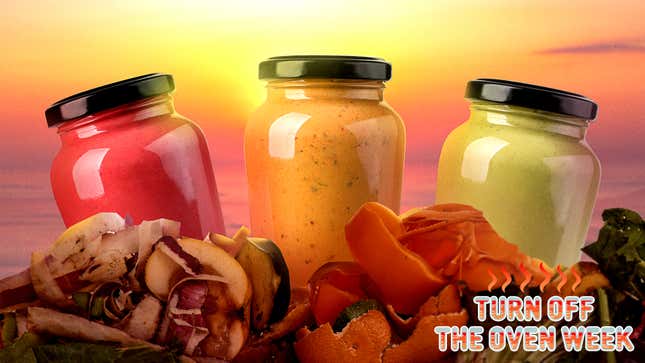
Welcome to Turn Off The Oven Week, featuring creative ways to beat the heat and stay far away from your stovetop.
There’s an overly salted ball of focaccia dough fermenting ominously in the compost bucket outside my house. I’m too scared to open the lid because I’m afraid it will burst forth like the Blob and slowly swallow my whole face.
During three-plus months of social isolation, I’ve had several of these spectacular bread baking fails. A couple weeks before the salty-as-Play-Doh focaccia exhausted my stores of active dry yeast and bread flour, I broke the KitchenAid mixer while mixing a batch of stiff bagel dough. To add insult to injury, the dough I finished kneading by hand yielded bagels barely larger than a silver dollar.
As I bitterly toasted a couple of toy bagels for breakfast, I had an important and freeing realization: I don’t really like baking. I’m a cook. Why am I doing this to myself? It was just like how I assumed quarantine would somehow turn me an ace at sewing face masks when I’d previously barely sewn so much as a button on a shirt.
I’m fortunate that the pandemic hasn’t imperiled my economic security or food access. But my baking fails remind me that in times of crisis, not all deliciousness must be hard won—no matter what those burnished home-baked loaves populating our Instagram feeds tell us. Survival necessitates shortcuts and stretching store-bought items to their fullest. And as we reach the stickiest days of summer, who wants to bake anyway?
There’s also profound joy in testing the limits of our resourcefulness. In my case, some emptying condiment jars lately became the springboard for a series of cold-dressing breakthroughs.
Reaching the sad dregs of the mayonnaise jar, I thought I’d venture a tangier take on Dijonnaise and dribbled in a few teaspoons of vinegar, a sprinkling of salt, and a wad each of Dijon mustard and minced garlic. I lidded it, shook mercilessly, then emptied its silky contents over velvety leaves of butter lettuce for lunch. When confronted with a similar quandary of the end of the yogurt container, Emboldened Me squeezed in lemon juice and olive oil, added a dusting of turmeric and salt, and then smeared the result inside a pita pocket (leftover from takeout!) with slivers of fresh cucumber and pan-fried lamb.
Naturally, the same notion applies to peanut butter dregs, which taste excellent shaken with soy sauce, honey, and lime juice and then poured over chilled soba noodles and topped with sliced green onion and sesame seeds. It also goes for the juicy, chili-flecked remains of the kimchi jar, which, when whisked with a couple of egg yolks and a few cloves of sliced garlic, morph into a glistening, umami-rich coating for warm udon noodles.

It wasn’t until a confrontation with the liquid remains of a spent can of pickled jalapeños—which I turned into a piquant, Italian-American-inspired salad dressing—that I appreciated what was happening. By building on the remains of a foundation that was already calibrated into something complete, I could create something that tasted invigoratingly fresh and different. It’s a wonderful reminder that we should re-examine what we already have before going out to the store for a new jar.
In the end, however, my successes with condiment dregs proved no match for my fragile baking ego. Once I replenished my stores of flour and yeast, I had another go at focaccia. This time, I triple-checked the salt measurement, and I Instagrammed the hell out of the mediocre results.

Jalapeño Juice Dressing
Yields ⅓ cup dressing (enough for one large salad)
This dressing lovingly riffs off one I tasted a few years ago at Mosca’s, the Italian-American stalwart in an old roadside house in Westwego, Louisiana. My companions and I started with Italian salad doused in a dressing we decided was probably made using pickled pepperoncini juice. Thus we renamed it “pickle salad.”
Equal parts fiery, salty, and sharp with a musty backbone of dried oregano and piquant tang of fresh onion, my version recalls the dressing on a proper Italian cold-cut sub—which, by the way, it’s delicious on. But I like it best tossed with a crunchy mixture of chopped celery, carrots, sturdy lettuce, sliced olives, slivers of red onion, a soft-boiled egg, and olive oil-fried croutons—made from a torn-up assortment of leftover bread butts, naturally.
- 2 tsp. grated or minced white or yellow onion
- 2 Tbsp. juice from a can or jar of pickled jalapeños
- 1 Tbsp. red wine vinegar
- ½ tsp. dried oregano
- Salt and freshly ground pepper to taste
- 3 Tbsp. extra virgin olive oil
In a small bowl, combine the onion, jalapeño juice, red wine vinegar, oregano, salt and pepper and give it a whisk. Slowly stream in the olive oil, whisking constantly, until combined. Taste and adjust the seasoning as needed with salt and pepper. Pour over a salad for two and toss, or drizzle atop a cold-cut sandwich piled high with salami, provolone, and shredded iceberg lettuce.
Note: For those finding joy in kitchen resourcefulness, I’d suggest food writer/author Tamar Adler’s excellent 2011 book, An Everlasting Meal: Cooking with Economy and Grace. Or go back further, to the apex of World War II rationing in 1942, when MFK Fisher penned How to Cook a Wolf as a guide to nourishing oneself during a crisis.